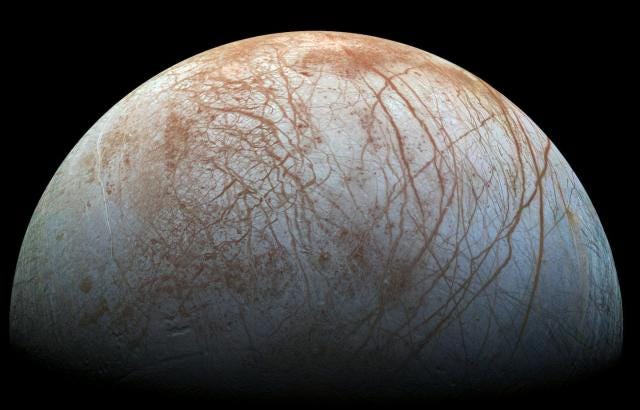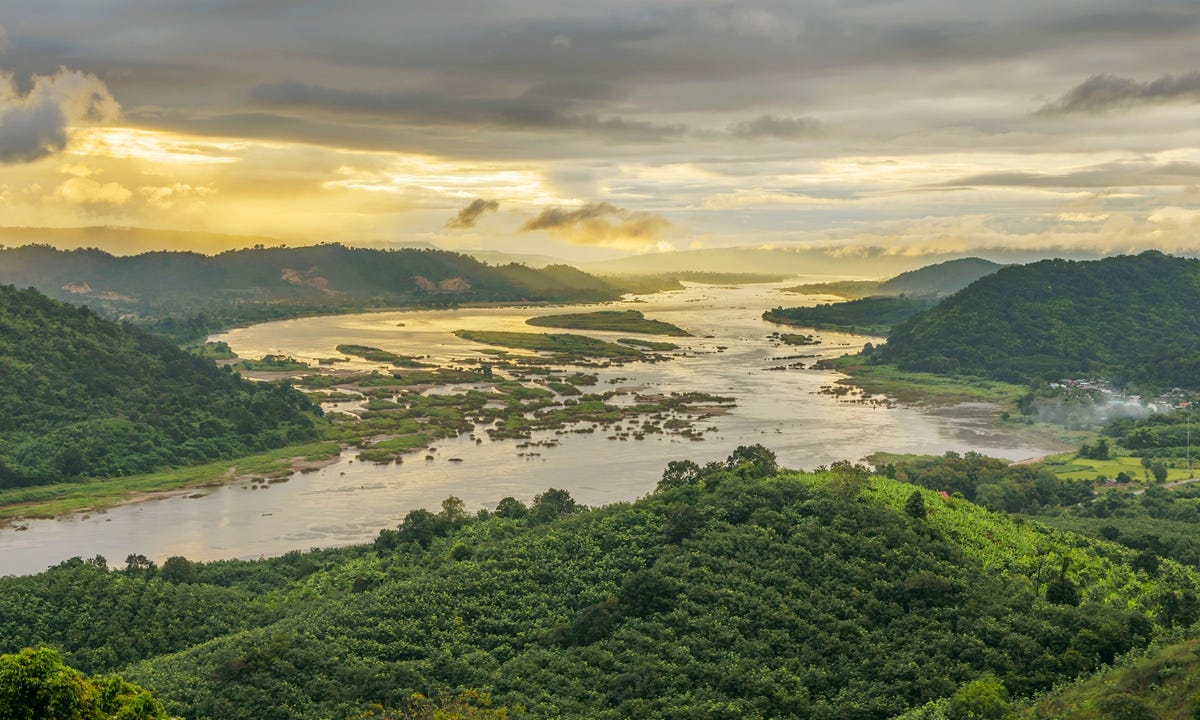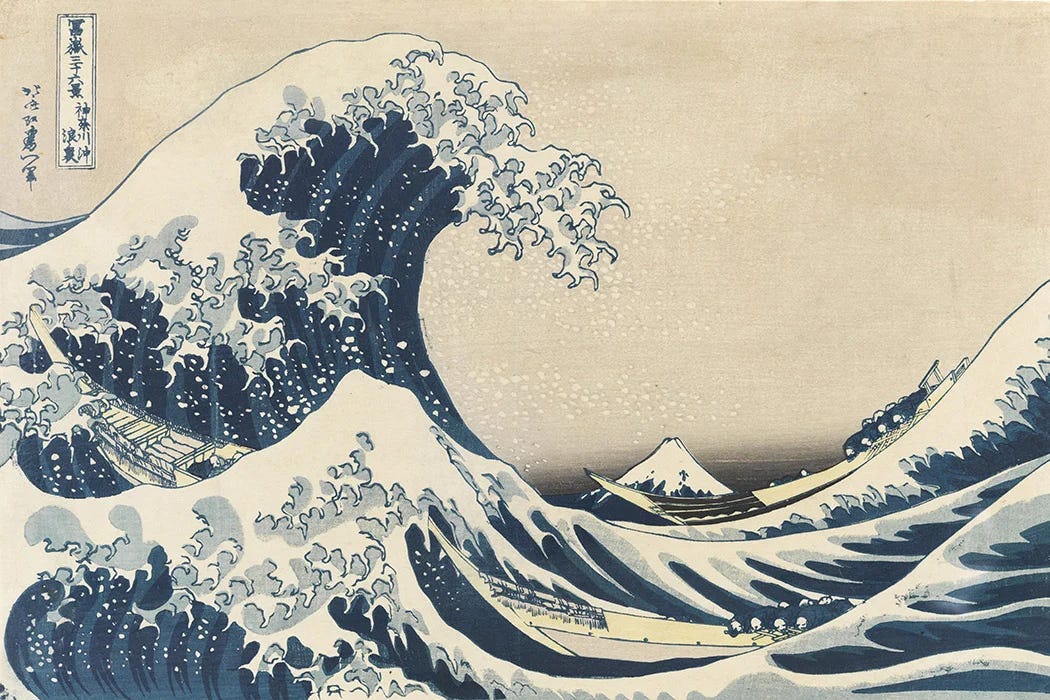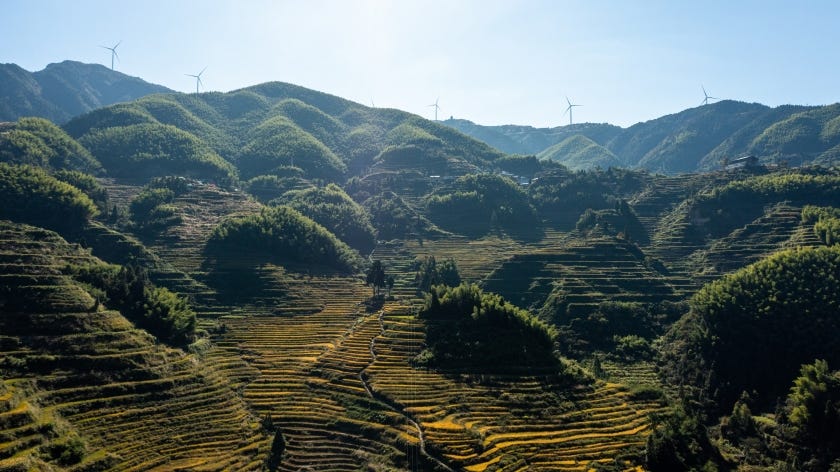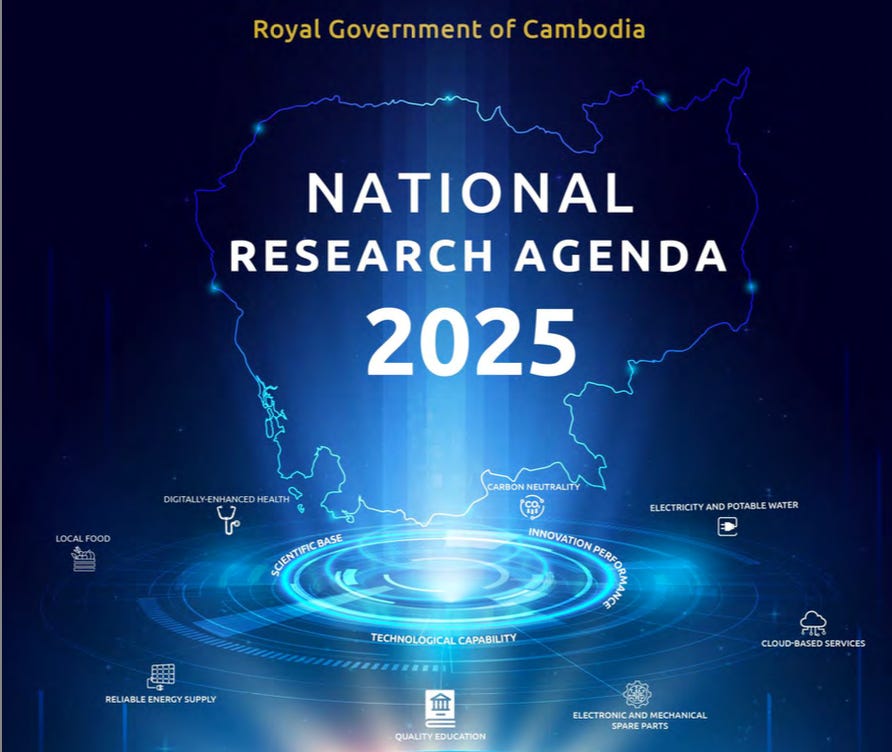Science and Society
water on Jupiter, China's water data flow, Hokusai woodblock prints, landscape restoration, Cambodia's research agenda
UPDATE: On April 13, 2023, the European Space Agency is scheduled to launch a rocket carrying a spacecraft destined for Jupiter. The Jupiter Icy Moons Explorer – or JUICE – will spend at least three years on Jupiter’s moons after it arrives in 2031.
Water data are essential for monitoring, managing, modelling and projecting water resources. Yet despite such data—including water quantity, quality, demand and ecology—being extensively collected in China, it remains difficult to access, use and share them.
Hokusai’s Great Wave is possibly the most recognised woodblock print on Earth, but as a digital collection from nearby Boston College demonstrates, many of Hokusai’s predecessors and contemporaries were skilled in the design and production of woodblock prints, or ukiyo-e.
In December, China and Canada rallied nations behind a new global agreement, the Kunming-Montreal Global Biodiversity Framework, to halt and reverse the destruction of nature. The accord included a massively scaled-up restoration effort.
A national innovation system grounded on a solid research framework is essential to deliver inclusive and sustainable development and create a resilient nation capable of navigating the uncertainties and opportunities of the Fourth Industrial Revolution.
Jupiter’s moons
On April 13, 2023, the European Space Agency is scheduled to launch a rocket carrying a spacecraft destined for Jupiter. The Jupiter Icy Moons Explorer – or JUICE – will spend at least three years on Jupiter’s moons after it arrives in 2031. In October 2024, NASA is also planning to launch a robotic spacecraft named Europa Clipper to the Jovian moons, highlighting an increased interest in these distant, but fascinating, places in the solar system.
I’m a planetary scientist who studies the structure and evolution of solid planets and moons in the solar system.
There are many reasons my colleagues and I are looking forward to getting the data that JUICE and Europa Clipper will hopefully be sending back to Earth in the 2030s. But perhaps the most exciting information will have to do with water. Three of Jupiter’s moons – Europa, Ganymede and Callisto – are home to large, underground oceans of liquid water that could support life.
Meet Io, Europa, Ganymede and Callisto
Jupiter has dozens of moons. Four of them in particular are of interest to planetary scientists.
Io, Europa, Ganymede and Callisto are, like Earth’s Moon, relatively large, spherical complex worlds. Two previous NASA missions have sent spacecraft to orbit the Jupiter system and collected data on these moons. The Galileo missionorbited Jupiter from 1995 to 2003 and led to geological discoveries on all four large moons. The Juno mission is still orbiting Jupiter today and has provided scientists with an unprecedented view into Jupiter’s composition, structure and space environment.
These missions and other observations revealed that Io, the closest of the four to its host planet, is abuzz with geological activity, including lava lakes, volcanic eruptions and tectonically formed mountains. But it is not home to large amounts of water.
Europa, Ganymede and Callisto, in contrast, have icy landscapes. Europa’s surface is a frozen wonderland with a young but complex history, possibly including icy analogs of plate tectonics and volcanoes. Ganymede, the largest moon in the entire solar system, is bigger than Mercury and has its own magnetic field generated internally from a liquid metal core. Callisto appears somewhat inert compared to the others, but serves as a valuable time capsule of an ancient past that is no longer accessible on the youthful surfaces of Europa and Io.
Most exciting of all: Europa, Ganymede and Callisto all almost certainly possess underground oceans of liquid water.
Read full article here.
Making China’s water data accessible, usable and shareable
Water data are essential for monitoring, managing, modelling and projecting water resources. Yet despite such data—including water quantity, quality, demand and ecology—being extensively collected in China, it remains difficult to access, use and share them. These challenges have led to poor data quality, duplication of effort and wasting of resources, limiting their utility for supporting decision-making in water resources policy and management. In this Perspective we discuss the current state of China’s water data collection, governance and sharing, the barriers to open-access water data and its impacts, and outline a path to establishing a national water data infrastructure to reform water resource management in China and support global water-data sharing initiatives.
Water has been central to the development of China’s ancient civilisation and to its contemporary development and industrialisation, and will shape its path to an ecological civilisation—an aspirational, more sustainable mode of human interaction with the environment. Chinese understanding of water and its management stems from the Neolithic period, supporting agriculture, irrigation and intensive cultivation. This has also involved extensive engineering and hydrology, as well as drought and flood management (for example, Yu the Great had a legendary ability to control floods around 4,100 yr bp) and defined Chinese culture (the Liangzhu culture developed in the context of extreme hydrological dynamics in the Yangtze delta around 5,100 yr bp). Today, and in the years to come, China’s burgeoning economy, cities and population desperately need access to scarce freshwater resources to support industry and ensure food and energy security, to manage the impacts of increasingly frequent and severe droughts and floods, and to improve the quality of water resources and water-dependent ecosystems given the impacts of industrialisation and urbanisation. Ready access to comprehensive, high-quality data on multiple aspects of surface, ground and coastal water resources (including quantity, quality, ecology, demand and infrastructure) is fundamental to understanding, managing and monitoring China’s water resources and meeting the nation’s commitment to the UN Sustainable Development Goals (SDGs), particularly SDG 6 (clean water and sanitation; refs. 8–10). However, although water data are extensively collected in China, governance and sharing lag well behind the international community.
Download article here.
Woodblock Prints: Katsushika Hokusai et al
Hokusai’s Great Wave is possibly the most recognised woodblock print on Earth, but as a digital collection from nearby Boston College demonstrates, many of Hokusai’s predecessors and contemporaries were skilled in the design and production of woodblock prints, or ukiyo-e.
Ukiyo-e translates literally as “picture(s) of the floating world.” Today, the term ukiyo-e is often used as shorthand for Tokugawa era
relief prints made from carved wooden blocks. Artists created views of landscapes and famous sites. Many of the prints attributed to Utagawa Hiroshige, a contemporary of Hokusai highlight the more remote countryside.
Exemplary of Hiroshige’s travel art is the well-known Fifty-three Stages of the Tōkaidō Road (c. 1833), a set of prints showcasing post stations along the road between Kyoto and Edo. In addition to classic ukiyo-e and landscapes of Hiroshige, Hokusai, and contemporaries, the online collection includes several examples of twentieth-century woodblock prints, representing both the folk art (mingei) and “creative prints” (sosaku hanga) traditions.
The bamboo trees and misted landscapes in the work of Imoto Tekiho are appropriately ethereal and mysterious. Un’ichi Hiratsuka’s view of a shrine garden, completed in 1953, highlights his bold carving style—he often rocked a square-end chisel to create rough, deep lines—and stark, monochromatic palette.
Read and see more here.
Science and tradition restore landscapes
The award underscores the key role China plays in addressing the triple planetary crisis of climate change, biodiversity and nature loss, and pollution and waste. In December, China and Canada rallied nations behind a new global agreement, the Kunming-Montreal Global Biodiversity Framework, to halt and reverse the destruction of nature. The accord included a massively scaled-up restoration effort.
An integrated approach
Launched in 2016, the initiative takes a systematic approach to restoration. Projects dovetail with national land use plans, work at the landscape or watershed scale, including agricultural and urban areas as well as natural ecosystems, and seek to boost rural economies. By enhancing ecosystems and the benefits they deliver, the projects promote the implementation of the UN Sustainable Development Goals, including those on poverty eradication, climate change and biodiversity.
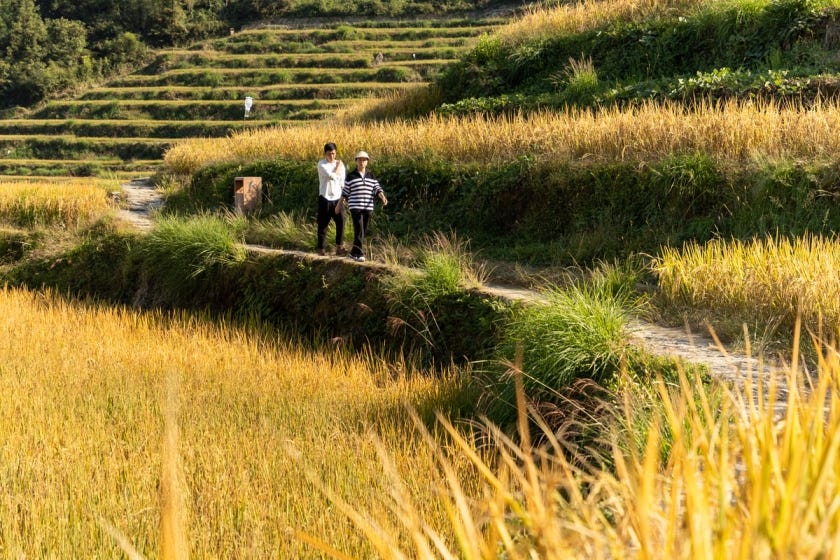
So far, 3.5 million hectares have been brought under restoration under the initiative, out of a 2030 target of restoring 12 million hectares. In all, the initiative is expected to create more than 3.2 million jobs and deliver benefits to some 360 million people. Critically endangered species that are benefitting include the Chinese sturgeon, birds like Baer’s pochard, and the Baishanzu fir, the world’s rarest conifer.
Several of the projects integrate scientific knowledge with traditional farming methods to make land use more sustainable.
About 100 km east of Yunhe, Xu Guanhong does not let pouring rain dampen his enthusiasm for how the fish swimming in his rice paddies mean that he does not need to treat his crop with either pesticides or artificial fertilizers. Xu, a former schoolteacher, says he took over some idle land near the town of Qingtian several years ago and began experimenting with organic farming methods. Local farmers were sceptical, and Xu’s yields were unreliable in the first two seasons. But now he is seeing results that have caught the interest of his neighbours.
“Our ancestors were smart. They put fish in the rice paddies and let them eat pests and weeds,” Xu told a visiting United Nations Environment Programme (UNEP) film crew, raindrops bouncing off his wide straw hat. “The faeces excreted by the fish provide nutrients for the rice. In my field, an ecological cycle is now underway without any fertilizer or pesticide.”
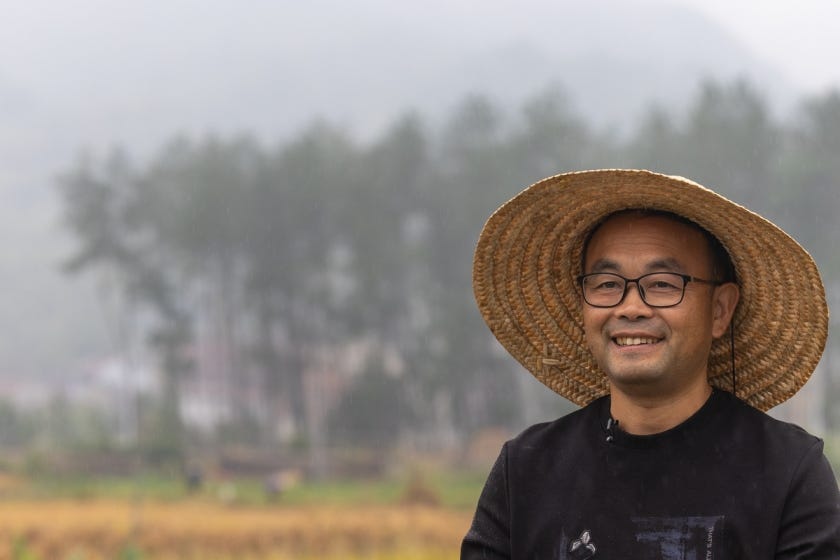
Liu Zhumei, a local farmer, says she has been adopting Xu’s methods, which also include monitoring water quality in rice paddies and installing equipment to maintain the level of dissolved oxygen.
“We didn't earn much before. But now, following these methods, we can earn as much as 60,700 yuan per acre,” Liu says. (10,000 Chinese yuan is about US$1,450.) “Consumers from other provinces also know that our fish here are pollution-free, so they sell very well.”
Restoring harmony
The Shan-Shui initiative is named after a traditional Chinese landscape painting style that depicts the harmony of land and water – a balance that human activities, including industry and agriculture, have often disturbed
Luo Ming, a restoration expert at the Land Consolidation and Rehabilitation Centre of China’s Ministry of Natural Resources, says people should again recognize that they form a “community of life” with nature, and depend on it for their well-being.
“This traditional wisdom has existed for thousands of years,” Luo says. “Such a system is not only good for the environment but also greatly increases the benefits for local people. It attracts people who love the way of life in which people and nature live in symbiosis, making it a sustainable model.”
Read full article here.
A national innovation system grounded on a solid research framework is essential to deliver inclusive and sustainable development and create a resilient nation capable of navigating the uncertainties and opportunities of the Fourth Industrial Revolution. The Royal Government of Cambodia believes that the curiosity and determination of Cambodian researchers, innovators and entrepreneurs are its greatest assets to regain the economic momentum lost during the COVID-19 pandemic and prepare the nation for present and future economic, societal and environmental challenges.
The United Nations Economic and Social Commission for Asia and the Pacific (ESCAP) is also committed to fostering research, science, technology and innovation (STI) for sustainable and inclusive development. As part of its mission, ESCAP has been partnering with Cambodia’s Ministry of Industry, Science, Technology & Innovation (MISTI) to support the development of landmark studies and evidence-based policies capable of unlocking the creative potential of the Cambodian people and guiding it towards the realisation of Cambodia’s Vision 2050.
The Royal Government of Cambodia established in 2020, the Ministry of Industry, Science, Technology, & Innovation (MISTI). With the advisory support from United Nations Economic and Social Commission for Asia and the Pacific (ESCAP), the Ministry developed Cambodia’s Science, Technology & Innovation Roadmap 2030 to implement the National Policy on Science Technology, and Innovation 2020-2030.
One of the actions envisaged in the Roadmap 2030 was to develop a National Research Agenda to enhance and direct investments in research. The Ministry of Industry, Science, Technology, & Innovation has developed with the support of ESCAP the National Research Agenda which identifies the critical scientific challenges for the future of Cambodia and prioritizes the allocation of research resources.
This event presented the official launch of Cambodia’s National Research Agenda 2025.
Cambodia's National Research Agenda 2025 (also available in Khmer download here)
For more on ESCAP’s work on promoting inclusive technology and innovation policies click here.




